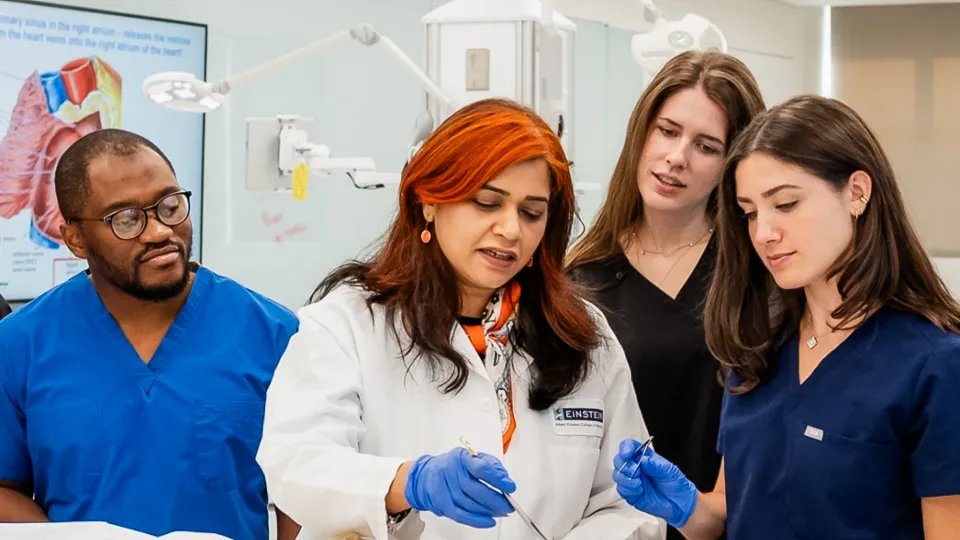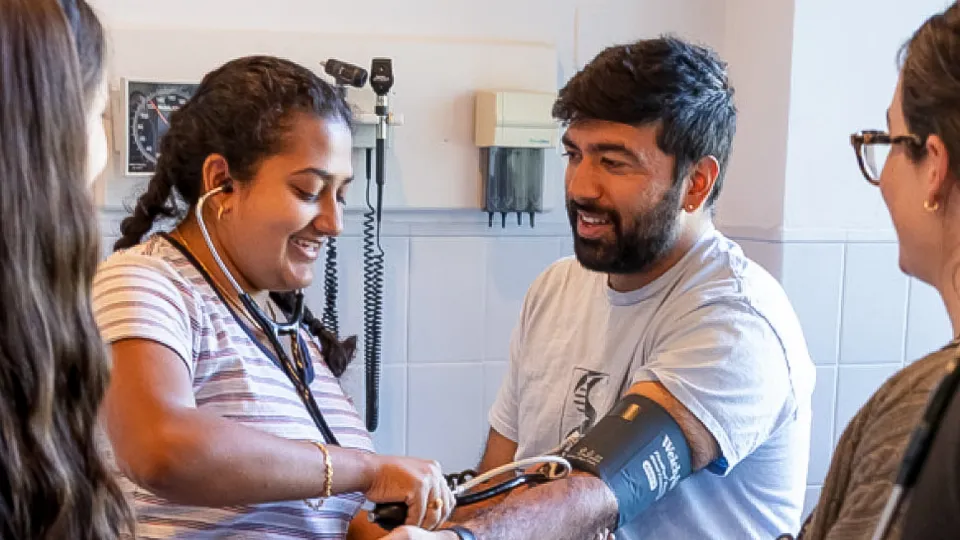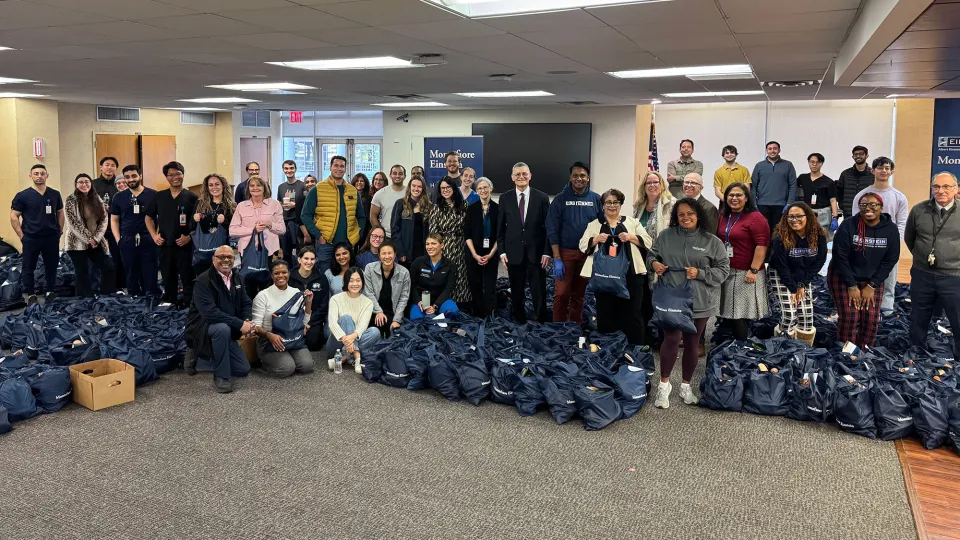Feature
From Students to Physicians: New Course Prepares Students for Hospital Roles
May 16, 2023
From updating their lifesaving skills on realistic mannequins to learning how to invest in their own wellness, Albert Einstein College of Medicine’s graduating medical students recently gained a better understanding of what to expect at the hospital when they begin their residencies in July. For four weeks this spring, members of the Class of 2023 attended Einstein’s new Transition to Residency course, designed to prepare them for their new roles as practicing physicians.

The extended course, part of Einstein’s curricular renewal, focused on integrating basic, clinical and health system sciences while providing students with opportunities to practice clinical skills, review key concepts and apply them to scenarios, simulations, and cases the students are likely to encounter during their internships (the first year of residency). The inaugural required course builds on a pilot “boot camp” elective Einstein offered in recent years.
“The most important goal of the Transition to Residency course is to ensure that our students enter their residencies prepared,” said Todd Cassese, M.D., professor of medicine and associate dean for medical education at Einstein and a hospitalist at Montefiore Health System. “Students found the previous boot camp valuable and challenging. Our new comprehensive course includes additional programming that incorporates common workflows and conditions encountered across a series of disciplines, covering topics that they need to know, no matter what specialty they enter, while also tailoring aspects of the experience to their chosen residency fields.”
Skill-Building and Critical Thinking
“Students often feel intimidated about the prospect of starting their residencies,” said Janice Thomas John, D.O., M.S., M.P.H., the Transition to Residency course director, assistant professor of pediatrics, and assistant dean for integrated medical education at Einstein and a pediatric hospitalist at the Children’s Hospital at Montefiore. “The schedule is difficult, the demands of clinical care are high, and new physicians face many stressors during rigorous training. We designed our course to smooth their transition to residency by providing critical thinking opportunities and hands-on training to further enhance the foundation for their success.”
The course began with a fast-paced, in-person session on best practices to respond to 10 common pages, or instant messages from other hospital personnel, that new residents receive, often in the middle of the night, such as patient chest pain, shortness of breath, and fever.
Later in the day, the students became the first class at Einstein to receive updated, in-depth training on caring for patients with opioid use disorder (OUD), helping them fulfill new training requirements that will allow them to prescribe medications for OUD as soon as they begin practicing medicine.
“Only about 14 percent of people with opioid use disorder, which is a chronic brain disease, received medication treatment over the past year in the United States, mostly because of stigma, fragmented care, outdated regulations and restrictive policies, and an inadequately trained workforce,” said session leader Tiffany Lu, M.D., M.S., associate professor of medicine and an addiction medicine physician at Montefiore. “In what world are we OK with that?” she asked, stressing the sharp rise of overdose deaths nationally and in New York City, where one person died of an overdose every three hours in 2021.
We designed our course to help smooth their transition and provide them with additional knowledge, critical thinking opportunities, and hands-on training to further enhance the foundation for their success.
Janice John, D.O., M.S.
The 8-hour training (with the second half later in the course) covered clinical assessment of people with OUD, guidance for using medications like buprenorphine and methadone, and common issues that affect OUD treatment, such as pain. Students also received overdose rescue kits containing intranasal naloxone, a medication that can reverse overdoses.
A few days later, instructors tested the students’ dexterity in a session on tying a square knot, often used by surgeons, internists, emergency medicine physicians, and obstetricians.
“You’re there, you’re there!” said the session leader, I. Martin Levy, M.D., encouraging a student as she grasped two ends of a rope attached to a table clamp and methodically paced through 12 moves to complete the knot. Her partner used a clicker each time she accomplished a step in the process. Dr. Levy, professor of orthopaedic surgery at Einstein and director of the orthopaedic residency program at Montefiore, said the clicker is a positive training method used successfully to mark and reinforce success. “Yes, I love it – BINGO!” he exclaimed, affirming the student’s neatly tied knot. By the end of the session, clicks echoed around him and students began working with thinner strings as they perfected their techniques.
Financial and Emotional Wellness
Kicking off the course’s second week, Martin Penn, M.B.A., instructor in the department of medicine and course director for a financial literacy elective, led a webinar on financial health that covered topics such as specialty-specific insurance, disability, and retirement planning.

“The largest investment you have made is in your training,” said Mr. Penn, who stressed the need for students to begin thinking about finances as they launch their medical careers. “It’s the greatest, most valuable asset you are ever going to have, and you must protect it. The planning has to begin very early.”
Investing in wellness was the topic of another interactive session. The students were asked: What comes to mind as you approach your upcoming transition to residency? Answers submitted in an online real-time poll immediately appeared in a “word cloud” displayed on screens in Riklis Auditorium. The most frequent answers were: stress, burnout, expensive, exhaustion, nervous, pain, poor, sad, and overwhelming.
“There is wisdom in your experience,” said one of the session’s moderators, Robert Shochet, M.D., professor of medicine and of psychiatry and behavioral sciences and senior director of patient experience at Montefiore. “Reflect on a high stress time you experienced in medical school. How did you cope with this, what did you learn about yourself in the process?”
The session also featured three Montefiore residents who described experiences during their early days as interns.
“It’s hard to make the transition from student to doctor,” said Michelle Williamson, M.D., a second-year psychiatry resident at Montefiore. “I remember during my first two months, a patient asked me a question and I said, ‘I’m going to ask the doctor about that.’ But I was the doctor!”
Mistakes and awkward encounters with patients and colleagues during residency are common, but they provide chances to learn and grow, panel members said.
“Stay in touch with your friends from medical school—they understand what you’re talking about and going through,” said Dr. Williamson. “And don’t make your experience a competition with your peers.”
The panelists also advised students to keep their mental health in mind and seek therapy if needed. “When you go home, the pace at which you’re operating is still frantic,” said Jayson Lian, M.D. ’19, an orthopaedic surgery resident at Montefiore. “Turn it down, take a deep breath.”
Sensitive Patient Care
Laila Khalid, M.B.B.S., M.P.H., associate professor of medicine at Einstein and an internist and addiction medicine physician at Montefiore, and Tartania Brown, M.D., clinical assistant professor of family and social medicine at Einstein, presented a session on pain management that included a case study involving a woman with sickle cell disease (SCD). In the case, the patient was referred to as “a frequent flyer always asking for more morphine.” Dr. Khalid said that such derogatory terms, which assume patients aren’t truthful about their pain or are seeking painkilling drugs, are dismissive, biased, and dangerous.
Near the end of the session, Dr. Khalid revealed that Dr. Brown was the patient described in the case study. Murmurs rippled through the audience, and seconds later, the surprised class applauded Dr. Brown. She continued the lecture with stories about her personal challenges of growing up with SCD, watching her brother almost die of the disease, managing her pain, and getting through medical school and residency.
Dr. Brown urged the students to practice good role modeling with all patients. “How we talk about patients matters,” she said. “Don’t assume patients with SCD and pain are lying. They really are going through what they’re going through. We are all just looking for someone to see us. For your patients, I’m advising you to do some active listening, believing, interacting, and engaging with them.”
Hands-On Simulations
During a dedicated day of interprofessional training and workshops at the Montefiore Einstein Center for Innovation in Simulation and the Ruth L. Gottesman Clinical Skills Center, the students rotated through hands-on practice of common clinical skills and participated in a patient simulation with students from Montefiore’s School of Nursing.

“When you work on the floors, these are the relationships you have to foster,” said Jay Berger, M.D., Ph.D., who co-led some of the simulations and is the newly named director of the Integration course, which oversees the Transition to Residency course. “The importance of interprofessional simulation is that it takes students out of their educational silos and allows them to practice real-world team-based medical care. The challenge of interprofessional care is the ability of healthcare providers to communicate effectively with one another.” Dr. Berger is also associate professor of anesthesiology at Einstein and an anesthesiologist and critical care physician at Montefiore.
The students were instructed, with limited guidance from faculty, to engage with and care for the patient, a high-fidelity mannequin that “breathed,” had measurable blood pressure and a pulse, and whose monitors displayed a range of measures, including EKG and blood oxygen levels. Using an embedded microphone and speakers, staff played the part of the patient and talked with the students. As the patient’s condition deteriorated, the students had to work together to determine the cause of his decline and provide urgent care.
“One of the most stressful things when thinking about residency is running codes,” said Einstein fourth-year student Errol Hunte, referring to the urgent call to begin resuscitative efforts at the bedside of a patient in cardiac arrest. “I’ve seen it before, but when you’re actually the one making the decisions, it feels very different,” said Mr. Hunte, who matched in general surgery to Brown University-Rhode Island Hospital. “Working with the nursing students showed me how important that relationship is and how clear, concise, and thorough you need to be in your instructions. Just going through the motions—like pulling out a board to put under the patient before doing chest compressions—has been really helpful.”

“These simulations are great,” said Michael Kates, M.S.N., R.N., at Montefiore School of Nursing, who co-led the simulation training. “Students get real-life scenarios, they can see the progression as a patient’s status changes—it really gets the adrenaline going and you see how they respond. And it doesn’t really matter if you make mistakes because afterward we do really informative debriefings and figure out what they would do differently.”
During the other half of the day, students rotated though four stations to learn a range of clinical skills. At the first two stations, they learned to use point-of-care ultrasound (POCUS) by imaging the heart and lungs of their fellow students and watching the image on an iPad. A third station focused on placing an IV, using both the standard technique and with ultrasound guidance. The fourth provided instruction, led by urologists, on placing a Foley catheter in both men and women.
"I frequently use ultrasound at the bedside in the ICU and it is increasingly being used by other specialties as well,” said Ali Naqvi, M.D., assistant director of the Integration course, assistant professor of medicine, and a critical care physician and program director of the critical care fellowship program at Montefiore. “Ultrasound is readily available and provides a wealth of information quickly. For example, if a patient is having difficulty breathing, I can use ultrasound to evaluate the heart and lungs in real time to guide my clinical decision making.”
Mitchell Veith, who matched in family medicine at Keck Medicine at the University of Southern California, was most interested in the introduction of ultrasound. “In family medicine, the next big thing is incorporating POCUS into clinical practice in all sorts of ways. It’s really helpful to have some experience with it before starting my residency.”
Matches and Reflections

At the end of the course’s third week, students gathered with friends and family in the Lubin courtyard to learn of their residency matches during Match Day. After a weekend of celebrations, they returned to labs and classrooms for the final Transition to Residency workshops and sessions.
About 40 students attended a review session in the anatomy lab. Instructors supervised a few future surgeons as they carefully gripped needle drivers, forceps, and scissors and slowly manipulated the instruments to close wounds and tie surgical knots. Nearby, those who matched to ophthalmology residencies hunched over trays, holding apple-sized cow eyes in their hands to review the anatomy of the eye and discuss common ophthalmological surgical approaches.
With several attending surgeons, Alma Rechnitzer, who matched in general surgery to Montefiore, practiced suturing and reviewed abdominal anatomy and the laparoscopic approach used for exploratory surgeries and kidney and liver transplantation.
“I really liked how the session leaders gave us free reign to utilize the anatomy session in whatever way we found most helpful, said Ms. Rechnitzer. “It worked well because there were so many faculty members with different expertise available to assist in whatever way we wanted. It was a great opportunity to start building relationships and to learn their teaching styles. They were so generous and patient in their teaching and I'm really looking forward to working with them.”
The course closed with a two-hour reflection and workshop led by Dr. John. “Internship year is going to be great and it’s going to be hard,” she said, playing snippets of Queen’s rock anthem “We are the Champions” and Bill Withers’ “Lean on Me” as reminders to be proud and to remain supportive of others. “Today is about gratitude, but we’re also looking to the future.”

To do that, Dr. John and several faculty members guided students in discussions about the essays they submitted when they applied to Einstein and their transformative journey to become physicians. She asked them to write personal mission statements for their upcoming new stage.
Pankush Kumar, 25, shared that he is returning—with a new level of personal and professional growth—to his family’s home in Bellerose, Queens, to begin a pediatrics residency at nearby Cohen Children’s Medical Center. He noted the unexpected full circle at play: At Cohen, he will rotate through the same emergency room his parents took him to as a 5-year-old after he rode his bike down a hill, smashed into a curb, and broke his elbow.
“It’s a little surreal in that sense,” he said, describing himself as “the weird kid who wasn’t afraid of shots” and who used to ask his pediatrician questions. “I remember the follow-up visits to check the arm to see if it was healing properly and thinking, ‘This is so cool that I could break an arm and it’s something that’s inside of me and they’re just putting it back together. This is like magic. It’s awesome, and I want to do this.’”
All these years later, he said, he will be guided by a personal mission to help others and his community each day, serving as an advocate who educates and empowers patients.
“The reflection session was very powerful,” said Mr. Kumar. “I don’t think I would have had that kind of space to reflect without it.”
The full course, he added, was very helpful: “I don’t know if one can ever feel confident going into residency,” he said, “but I definitely feel more confident than I did when I started this transition course.”



